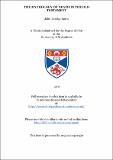Files in this item
The mythology of death in the Old Testament
Item metadata
| dc.contributor.advisor | McKane, William | |
| dc.contributor.author | Burns, John Barclay | |
| dc.coverage.spatial | ii, 356 p. | en_US |
| dc.date.accessioned | 2018-05-25T15:30:35Z | |
| dc.date.available | 2018-05-25T15:30:35Z | |
| dc.date.issued | 1970 | |
| dc.identifier.uri | https://hdl.handle.net/10023/13546 | |
| dc.description.abstract | The Preface examines the concept of life in the Old Testament which is discovered to be centred firmly on this world; special reference is made to life in the Wisdom Literature. Death at the end of a long and full life was accepted with resignation. Despite the paucity of references to death and the underworld in the Old Testament, there are passages which contain references to the mythology of death. The first chapter provides a background by reviewing the relevant aspects of the mythology of death in Egypt, Mesopotamia and Canaan. Chapter 2 lists the names for the underworld in the Old Testament end considers the mythological allusions which contain references to the location and characteristics of the underworld. Chapter 3 discusses the dwellers in the underworld. The words rp'um in the Ugaritic texts and rp'm in Phoenician inscriptions are surveyed as a background to rephaim in the Old Testament, The practices of necromancy and tomb-offerings are considered and it is concluded that while popular practice condoned them, official religion condemned them. In the fourth chapter the relation between the world ocean and the nether world is set out. As in the rest of the Ancient Near East the underworld was represented as lying in the depths of the ocean at the foot of the pillars which supported the earth. The deceased had to traverse this ocean on his way to the underworld. Chapter 5 deals with the concept of Sheol as a monster with gaping jaws and an insatiable appetite. This figure owes its ultimate origin to the Ugaritic god of death, Mot, whose ravenous appetite was proverbial. The sixth chapter surveys the personifications of death as a hunter, a shepherd and a robber. The powers of the underworld such as Abaddon, Sheol, Death the King of Terrors and the First-born of Death are discussed. In conclusion, it is observed that the mythological allusions are fragmented and moribund, serving, for the most part, a literary purpose within the context of the Old Testament. Death was an experience which meant the cessation of all life. | en_US |
| dc.language.iso | en | en_US |
| dc.publisher | University of St Andrews | |
| dc.subject.lcsh | Death--Religious aspects--Christianity. | en |
| dc.title | The mythology of death in the Old Testament | en_US |
| dc.type | Thesis | en_US |
| dc.accrualMethod | BT825.B8 | en |
| dc.type.qualificationlevel | Doctoral | en_US |
| dc.type.qualificationname | PhD Doctor of Philosophy | en_US |
| dc.publisher.institution | The University of St Andrews | en_US |
This item appears in the following Collection(s)
Items in the St Andrews Research Repository are protected by copyright, with all rights reserved, unless otherwise indicated.

